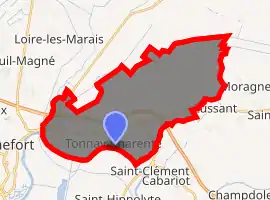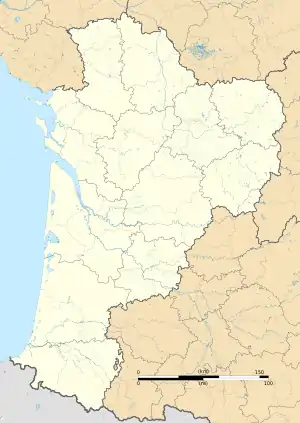Tonnay-Charente
Tonnay-Charente is a commune in the Charente-Maritime department in southwestern France.
Tonnay-Charente | |
|---|---|
 The river Charente | |
 Coat of arms | |
Location of Tonnay-Charente 
| |
 Tonnay-Charente  Tonnay-Charente | |
| Coordinates: 45°56′55″N 0°54′27″W | |
| Country | France |
| Region | Nouvelle-Aquitaine |
| Department | Charente-Maritime |
| Arrondissement | Rochefort |
| Canton | Tonnay-Charente |
| Intercommunality | Pays Rochefortais |
| Government | |
| • Mayor (2008–2014) | Jean-Pierre Guillon |
| Area 1 | 34.39 km2 (13.28 sq mi) |
| Population (2017-01-01)[1] | 8,010 |
| • Density | 230/km2 (600/sq mi) |
| Time zone | UTC+01:00 (CET) |
| • Summer (DST) | UTC+02:00 (CEST) |
| INSEE/Postal code | 17449 /17430 |
| Elevation | 1–32 m (3.3–105.0 ft) |
| 1 French Land Register data, which excludes lakes, ponds, glaciers > 1 km2 (0.386 sq mi or 247 acres) and river estuaries. | |
In the 18th century it was the home town of Prominent Irish Physician Dr. Theobald Jennings and his son Irish born French General Charles Edward Jennings de Kilmaine, who fought in the American war of Independence and more significantly in the French revolutionary wars with Napoleon I of France.
There is a personal portrait of General Kilmaine in the Hotel de Ville (City Hall) of Tonnay-Charente.
Rue Kilmaine, a street in Tonnay-Charente was named in his honor.
Population
| Year | Pop. | ±% |
|---|---|---|
| 1793 | 2,428 | — |
| 1800 | 2,275 | −6.3% |
| 1806 | 2,377 | +4.5% |
| 1821 | 1,173 | −50.7% |
| 1831 | 2,106 | +79.5% |
| 1836 | 3,202 | +52.0% |
| 1841 | 3,435 | +7.3% |
| 1846 | 3,296 | −4.0% |
| 1851 | 3,538 | +7.3% |
| 1856 | 3,699 | +4.6% |
| 1861 | 3,703 | +0.1% |
| 1866 | 3,763 | +1.6% |
| 1872 | 3,872 | +2.9% |
| 1876 | 3,756 | −3.0% |
| 1881 | 3,904 | +3.9% |
| 1886 | 4,287 | +9.8% |
| 1891 | 4,249 | −0.9% |
| 1896 | 4,462 | +5.0% |
| 1901 | 4,696 | +5.2% |
| 1906 | 4,873 | +3.8% |
| 1911 | 4,911 | +0.8% |
| 1921 | 4,529 | −7.8% |
| 1926 | 4,495 | −0.8% |
| 1931 | 4,537 | +0.9% |
| 1936 | 4,859 | +7.1% |
| 1946 | 4,830 | −0.6% |
| 1954 | 5,161 | +6.9% |
| 1962 | 5,732 | +11.1% |
| 1968 | 6,332 | +10.5% |
| 1975 | 6,430 | +1.5% |
| 1982 | 6,380 | −0.8% |
| 1990 | 6,814 | +6.8% |
| 1999 | 6,628 | −2.7% |
| 2008 | 7,792 | +17.6% |
References
- "Populations légales 2017". INSEE. Retrieved 6 January 2020.
This article is issued from Wikipedia. The text is licensed under Creative Commons - Attribution - Sharealike. Additional terms may apply for the media files.